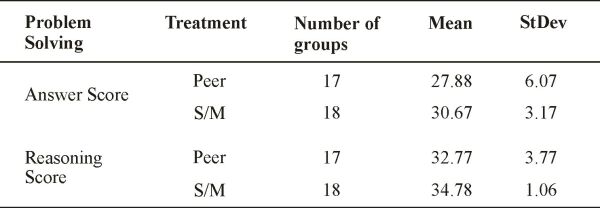
Authors
Ke Zhang is Assistant Professor of Instructional Technology
at the Texas Technology University. She can be reached by email at: ke.zhang@ttu.edu,
on the phone at: 1-806-742-1997 ext.322, or by mail at: 272 College of
Education, Texas Technology University, Lubbock, TX 79409, USA. Communications
regarding this article should be addressed to Ke Zhang.
Kyle Peck is Professor of Education and Chair of the Learning
and Performance Systems Department at Penn State University. His email is:
kpeck@psu.edu.
Abstract. This study investigated the relative benefits of peer-controlled and moderated online collaboration during group problem solving. Thirty-five self-selected groups of four or five students were randomly assigned to the two conditions, which used the same online collaborative tool to solve twelve problem scenarios in an undergraduate statistics course. A score for the correctness of the solutions and a reasoning score were analyzed. A survey was administered to reveal differences in students' related attitudes. Three conclusions were reached:
Résumé. Cette étude a examiné les avantages relatifs d'une collaboration en ligne contrôlée par des pairs et animée, dans le cadre d'une résolution de problèmes en groupe. Trente-cinq groupes autosélectionnés de quatre à cinq étudiants chacun ont été affectés au hasard aux deux types de coopération, qui utilisaient le même outil de collaboration en ligne pour résoudre douze scénarios de problèmes dans un cours de statistiques de premier cycle. Les notes relatives à l'exactitude des solutions et au raisonnement ont été analysées. Un sondage a été mené pour révéler les différences d'attitudes des étudiants pour les deux types de collaboration. Nous en avons tiré trois conclusions:
Vygotsky (1978) proposed that social interactions play a very important role in learning, and recent research demonstrates that working in small groups can facilitate group learning (Bruffee, 1999; Hamm & Adams, 1992; Johnson & Johnson, 1975, 1987). As a result, collaborative learning has become increasingly popular in both face-to-face and distance education settings.
Computer technologies, as demonstrated in research and practice, can support collaborative learning and be beneficial to learners in different ways (Bonk & Cunningham, 1998; Harasim, 1990; Scardamalia & Bereiter, 1994). For example, computer technologies make collaborative learning achievable even when face-to-face communications are difficult or impossible, and they can be employed to support reflection and improve the quality of the learning-related conversation (Lin, Hmelo, Kinzer, & Secules, 1999; Schwartz, Lin, Brophy, & Bransford, 1999). This study investigated the relative effectiveness of two approaches to the management and execution of online forums during group problem solving.
One of Vygotsky's most influential contributions was the analysis of human learning from a social-cultural history perspective (Gredler, 1997). Vygotsky (1978) proposed that learning is a developmental process occurring in social activities, and that higher-order, complex thinking is gradually developed through social interactions with others in the culture (Driscoll, 1994).
As Vygotsky and other socio-cultural theorists point out, people learn from mediations and scaffoldings, which are offered within one's "zone of proximal development" (ZPD) from more capable peers or experts (Bonk & Cunningham, 1998; Gredler, 1997; Wertsch, 1985). Vygotsky defines the ZPD, one of the key concepts in socio-cultural theory, as the distance between one's independent competency and the competency obtained with expert assistance or in collaboration with peers (Wertsch, 1985). In collaborative learning environments, a learner's ZPD can be reached and extended with scaffolds through different agents, such as instructors, peer learners and supporting materials (Bonk & Cunningham, 1998; Gredler, 1997; Wertsch, 1985). Hannafin, Land, and Oliver (1999) classify scaffolding into four types: conceptual, metacognitive, procedural and strategic. Conceptual scaffolds guide students in what to consider; metacognitive scaffolds are about how to think; procedural scaffolds guide students how in to utilize the available features for learning purposes; and strategic scaffolds provide macro-strategy as needed (Hannafin et al, 1999). Prompts, guidelines, and questions can also serve as scaffolds (Bonk & Cunningham, 1998).
Some studies indicate that a facilitator or moderator can smooth the process of collaboration (Hooper, 1992a, 1992b; Johnson, Johnson, & Stanne, 1986; Ruberg, Moore, & Taylor, 1996). Research also shows that successful group learning promotes higher order thinking (Blumenfeld, Marx, Soloway, & Krajcik, 1996). As educators and researchers stress the importance of problem solving (e.g., Bransford, Brown, & Cocking, 2000; Bransford, Sherwood, & Sturdevant, 1987; Bransford & Stein, 1993; Jonassen, 1997; Schmidt, 1989), problem-based learning (PBL) has been increasingly practiced in a variety of fields, such as medicine, law, engineering, social work, and agriculture (Barrows & Tamblyn, 1980; Boud, 1985; Bouhuijs, Schmidt, & Berkel, 1993). It is often emphasized that the instructor plays a critical role in the problem-based learning process, as a moderator or facilitator to foster active and effective learning (e.g., Barrows & Tamblyn, 1980; Barrows, 1985, 1996; Coles, 1991). As researchers report the various challenges faced by learners in online PBL (e.g., Lohman & Finkelstein, 2000; Orrill, 2000; Sage, 2000) and online collaborative learning (e.g., Zhang & Harkness, 2002), a skillful moderator may help address some of the issues and challenges in the group learning process. Research suggests, therefore, that if learning is largely a social activity, if learning in groups generally improves student learning, if successful group work can improve higher-order thinking, and if a facilitator/moderator can improve collaboration, then facilitation of online collaboration might be expected to improve performance in a group problem-solving task.
This study set out to answer four questions:
Some studies report that when participants have more active control over the learning process, learning increases (Jensen, 1996). Therefore less instructor participation may foster more active learning. Another study (Aviv & Golan, 1998), however, indicates that students' participation in electronic discussion is often minimal without an instructor's participation. Researchers (Aviv & Golan, 1998) report that in electronic discussions most students participate passively and only respond to a few messages, and very few students ask questions. They also propose that electronic discussions can result in a successful learning experience when they are planned, focused, and guided throughout the process.
Research indicates that in online learning environments, moderation and structuring of the process can be important contributors to a successful learning experience (Flannery, 1994). When changed from the "center of authority" to "co-conspirator," instructors assume substantial responsibilities to cultivate and promote a learner-centered collaborative learning environment. "Free riding" and "social loafing" in teamwork have negative impacts on group dynamics and team performance.
However, little research has formally investigated alternative methods of structuring peer online collaboration. In practice, peer collaborations are often structured by learners when they split the group task into smaller pieces and each take charge of part of the task (Althauser & Matuga, 1998). In order to reduce "free riding" in group work, instructors then often try to structure the online peer collaborations by assigning a set of questions to each member of a group. In such cases, every group member must participate in the part of the task to which they are assigned. Such structuring, however, tends to lead students to work on the group assignment in a cooperative way instead of collaboratively - individuals can complete their own part of the assignment without participation or contribution from peers, and they may, but usually do not contribute to parts of the assignment directed toward others.
Bosworth and Hamilton (1994) suggest that instructors direct both the structure of the teamwork and collaboration process to improve collaborative learning. Based on this advice, two strategies are employed to structure the online collaboration in the treatment group in this study: (a) Two moderators, through joint efforts, structured the group work by requesting each member's original contributions and meaningful, constructive responses to contributions of others; and (b) they also jointly moderated the collaboration process. Based on a review of the literature on moderating online collaboration (e.g., Flannery, 1994; Hamm & Adams, 1992; Harasim, 1990), the moderators in this study, in addition to the structuring efforts, were asked to: (a) help the teams keep the discussion on the topic; (b) make sure everyone knew the purpose of the forum and used it appropriately; (c) check group progress and remind users of the timetable; and (d) encourage and support individuals for equal participation. The moderators provided the four types of scaffoldings, as classified by Hannafin et al (1999), as needed. The two moderators worked together, deciding when and how to respond.
The study was a randomized, post-test only, control group design. The independent variable manipulated was the method of peer online collaboration (peer-controlled or structured and moderated). Thirty-five self-selected groups of four or five peers were randomly assigned to either the control (peer-controlled) or the treatment (structured and moderated). To further promote collaboration outside the private groups, a public forum was set up for each condition so that students could seek assistance on issues and problems that were challenging for their private team. The dependent variables were the group achievement score on the problem solving assignment (the answer score for the correctness of solutions), the quality of the argumentation provided with the solutions, which was measured by a "reasoning score", and students' perceived difficulty of collaboration, perceived value of collaboration, probability of future use of an online collaborative forum, and time spent using each collaboration medium. An open-ended survey (Appendix A) was conducted upon completion of the assignment to obtain the data for the last four variables.
The study was implemented in a large undergraduate introductory statistics course at a major university in the northeastern United States. This course, required by approximately sixty academic programs in eleven colleges and schools at the university, contained students from all classes (freshman to senior) and included students with varied academic backgrounds. One hundred and forty eight students volunteered to participate in this study. The participants had experienced other tasks requiring teamwork in this course prior to this study. Before the study began, the instructor asked the students to re-organize their existing groups into groups of four or five students, choosing their own team members. These self-selected groups were then randomly assigned to either the peer controlled online collaboration or structured and moderated online collaboration condition.
Approximately five weeks before the study started, students were given hands-on instruction on the use of the online forums. Detailed job-aids on the use of the forums were available in printed form and online. Students were given opportunities in the computer lab sessions to practice accessing the forums and posting and replying to messages on the private and the public forums. Two weeks after the initial introduction of the forums, students were encouraged to use the online forum as an option for team collaboration and communications with the instructor on a group project. Some groups started using the private forum to communicate with their teammates then, even though it was not required.
Because the academic content of this study consisted of the topics of inference and regression, which were considered the most difficult topics in this course, students were offered a rich context about which to engage in peer collaboration. The problems used in this study were twelve scenarios in which one statistical technique can be used most appropriately to address the problem or answer the question raised in the scenario. Because the cases left students a great deal of freedom in determining the most appropriate methods to solve the problem, they warranted team collaboration to reach consensus. As an example, one of the problem scenarios is provided below:
"A politician asserted that only 40% of the American public supported the use of ground troops in Kosovo. Secretary of Defense Cohen disputed this, saying it was certainly more than 40%. A CNN poll of 850 people showed that 442, or 52%, did favor the use of ground troops. Who do you think is right—the politician or Cohen?"
Each scenario was presented as a two-part assignment. First, students were to recommend an appropriate statistical technique to address the problem, then they were to briefly report their reasoning for recommending that technique. The correctness of the recommendation of a statistical technique was scored and reported as the "answer score" in this study. In order to align the score produced with the grading system of this course, three points were awarded for a correct answer to each of the 12 problem scenarios. No partial credit was given when an inappropriate statistical technique was recommended, so the answer score could range from 0 to 36. The reasoning score was established by assessing the quality of the explanation for the selection of each statistical technique they recommended. Three points were also possible for the reasoning score for each scenario, but partial credit could be assigned according to the match between the response and the categories identified on a scoring rubric (See Appendix B). Like the answer score, the reasoning score could range from 0 to 36.
When the problem solving assignment was completed, an open-ended, individual survey (Appendix A) was conducted to gather additional data on perceived collaboration difficulty, perceived value of collaboration and probability of future use of a collaborative forum.
All group assignments were blind reviewed and scored for correctness by two raters. The correlation of the two rater's answer scores was 1.000 (the answer scores were identical for both raters). The raters also worked independently to develop reasoning scores. The correlation of the two rater's independent assessments of reasoning scores was 0.990. In their ratings of the twelve problem scenarios for the thirty-five groups (420 scores in total), the raters disagreed on five, differing by only one point on four items and by two points on one. The two raters then worked together, jointly re-scoring these five items, and the negotiated scores were reported and analyzed in this study.
As the odd and even halves of the test were considered parallel and the assessment was not timed, an odd-even split-halves procedure was executed to examine the reliability of the assessment (Nitko, 1996). For both answer scores and reasoning scores, the even and odd halves of the assessment were significantly correlated (p values were 0.007 and 0.000 respectively).
Data collected through the three open-ended questions in the survey were classified by the lead researcher into the following four categories: "yes"; "no"; "maybe"; and "maybe not". "Yes" or "no" responses to these open-ended questions were reported as they were. Responses like "very likely", "probably", "maybe", "perhaps", and "possibly" were reported as "maybe", and responses like "maybe not", "not very likely", "probably not" were reported as "maybe not."
The groups in this study were from three different sections of the same course with the same instructor. Because it was possible that the three sections were different in terms of students' academic performance, motivation, and other important factors, computer software was used to perform a block randomization so that each treatment was randomly assigned with the same number of groups from each section.
Peer controlled treatment. Each group in this treatment was required to collaborate in a private, peer-controlled online forum, to which only members of the group had access. No moderator was assigned. A public forum was also made available to all members of all groups in this treatment. Also a peer-controlled public forum, this tool was made available so that students could choose to publish problems and issues they were not able to solve within a group to the public forum, to reach a broader audience. No moderation, scaffolding, or structuring efforts were implemented in any of the forums available to these groups.
Structured and moderated treatment. Each group in this treatment was provided a private structured and moderated online forum, to which only group members had access. In addition, a structured and moderated public forum was made available to all of the subjects in all of the groups receiving this treatment, so that students could choose to publish problems and issues they were not able to solve within a group to the public forum ,in orderto reach a broader audience.
For each group assigned to this condition, collaborations in both the private and public forums were structured and moderated with scaffolding, as needed, by two moderators, the instructor and a graduate assistant, to promote learning and thinking. Before the study was implemented, both moderators were trained on how to support peer online collaborations through structuring, moderating and scaffolding efforts. The lead researcher introduced the moderators to relevant literature and provided examples of structuring, moderating and scaffolding efforts in similar online collaborative learning environments. Using online collaboration transcripts from other courses as examples, the lead researcher and the moderators worked together to identify possible interventions for this particular course. A worksheet was provided to the moderators on which to record the interventions, media used, and group reactions, as applicable.
Two strategies were employed to structure the online collaboration for groups assigned to this condition: (a) Two moderators, through joint efforts, structured the group work by requesting each member's original contributions and meaningful, constructive responses to contributions of others; and (b) they also jointly moderated the collaboration process. The moderators were also asked to: (a) help the teams keep the discussion on the topic; (b) make sure everyone knew the purpose of the forum and could use it appropriately; (c) check group progress and remind users of the timetable; and (d) encourage and support individuals for equal participation. In addition, the moderators provided the four types of scaffolding, as classified by Hannafin et al (1999), as needed. Throughout the course of online collaboration, the two moderators worked together and provided all the structuring, moderating and scaffolding through online forums and private email.
The moderators never gave any direct answers to specific statistics-related questions. Most moderating and structuring efforts were delivered through online forum messages, with some provided through private emails to individuals as appropriate. All messages from the moderators were written in conversational style in order to foster student participation (Ahern, Peck, & Laycock, 1992). With scaffolding and moderating efforts, the moderators assisted with non-statistics issues such as team dynamics and team processing , and helped with the problem-solving task only indirectly.
The same two moderators jointly served all the treatment groups, behaving in accordance with the recommendations, which were described earlier. Examples of the types of moderation included:
Conceptual moderation (22 times, all through online forums). The moderators provided clarification on the usage of the public and private forums when students seemed to be uncertain of the difference between the two, and encouraged participation on both types of forums as appropriate.
Metacognitive moderation (4 times, all through online forums). Moderators posted conversational prompts such as: " Seems that you have a little trouble with #6? What did you do in the last project? Is there anything you learned there that might be helpful?" When a group seemed unclear about where to start with the problems, the moderators posted the following message:
"You may want to start by asking yourself: What type of data is sought in the scenario? How many samples are there? Is there a comparison? Also, think about what we talked about before, and what you did in previous projects. Is there anything that might be helpful? By working with these small questions, I believe you'll soon be able to figure it out. Good luck!"
Procedural moderation (17 times, all through online forums). The moderators reminded the groups of the built-in calculator and other simulation functions in the course website.
Strategic moderation (266 times, through a combination of the online forums and private emails). Two types of strategic scaffolds were employed: one was related to strategic team work, the other was related to solving the problems themselves, as stated in the opening posting in every group private forum. The moderators helped the groups to think about group work strategy as well as online collaboration strategy. For example, when a group was planning on a real-time collaboration through the online forum, the moderators suggested that they set an agenda first, and discuss how they would like to proceed in detail before the real-time online conference.
Table 1 below shows the number of groups and students in each treatment group.
Table 1.
Subjects by Treatment
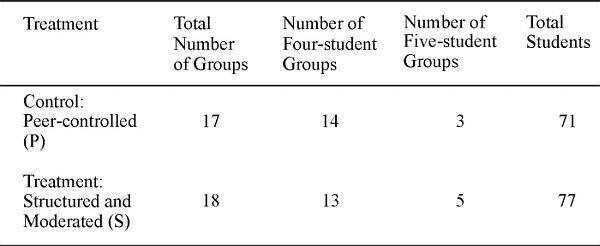
The answer scores and reasoning scores in the peer-controlled online peer collaboration groups ranged respectively from 12 to 36, and from 24 to 36; and those scores in the structured and moderated peer online collaboration forums ranged from 24 to 36, and 32 to 36 respectively. Means and standard deviations are shown in Table 2 below.
Table 2.
Performance Data Achieved by Treatment Group

Treatment and correctness of solutions.As indicated in Table 3 below, there is no statistically significant difference (p = .096) between the means for "answer score" exhibited by the peer-controlled online collaboration groups and the structured and moderated peer online collaboration groups.
Table 3.
One-Way Analysis of Variance for Answer Score

Treatment and reasoning during problem solving .As shown in Table 4 below, there is a statistically significant difference (p = 0.032) between the means of reasoning scores exhibited by the peer-controlled groups and the structured and moderated groups. The structured and moderated forums appear to be more effective in developing reasoning during group problem solving tasks.
Table 4.
One Way Analysis of Variance for Reasoning Scores

When students had completed all of the group assignments, they were asked to fill out a survey (see Appendix A), individually. Their perceptions about the media used for team collaboration on this assignment, the time spent on the task with each method of collaboration, and preference for future use of an online forum for peer collaboration were investigated.
Treatment and time spent on communication.The data related to the amount of time spent in different types of interaction are exhibited in Table 5. None of the differences in time spent by the two treatment groups were statistically significant. Although the groups in the structured and moderated forums reported making significantly more phone calls, the total time spent on the phone was not significantly different between the two treatments.
Table 5.
Survey Data on Time Spent in Collaboration
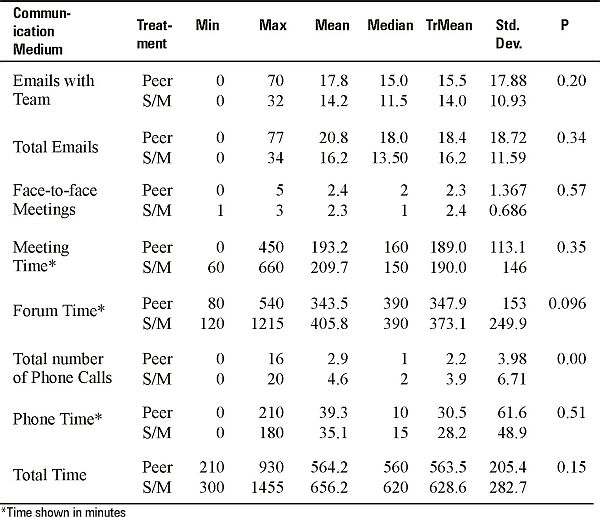
Treatment and the perceived difficulty and value of collaboration .The survey data also probed students' perceptions regarding the effort required and the value of teamwork, peer collaboration, and the online forums, as illustrated in Table 6.
Table 6.
Survey Data Regarding Teamwork and Online Forum

More than 90% of students in both the peer-controlled and the structured and moderated conditions found that online peer collaboration was valuable, and approximately 3/4 of the students in both groups reported that it was not difficult. The self-reported differences were not statistically significantly different for the two treatment groups, neither for perceived difficulty (F = 1.36; MSE = 0.193; p = 0.246) nor for the perceived value of collaboration (F = 0.00; MSE = 0.071; p = 0.976). In other words, the different approaches to online collaboration did not lead to differences in individual learner's perceptions of the difficulty of group work or the perceived value of collaboration.
Treatment and probability of future use.The data in Table 7 below represent a significant relationship between the type of forum used in this study and students' attitudes toward the use of optional online forums in the future, with students from the moderated treatment significantly more likely to report the desire to use online collaboration in the future.
Table 7.
Online Collaboration Approach And Preference For Future Use Of Online
Forums
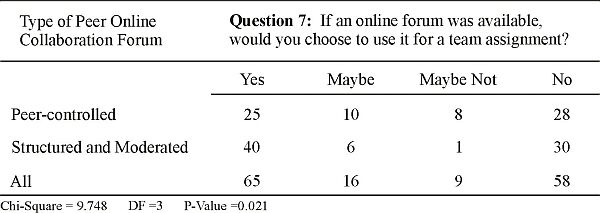
Difficulty of group collaboration and future preference for online forums.The data displayed as Table 8 show a significant and perhaps predictable relationship between the perceived difficulty of collaboration and students' attitudes toward use of online forums in the future. Students who found such communication difficult reported being less likely to use such systems in the future.
Table 8.
Collaboration Difficulty and Preference for Future Use of Online
Forums
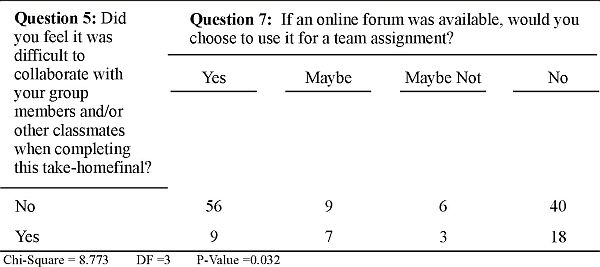
Perceived value of online collaboration and future preference for online forums. Table 9 shows students' perceptions of the value of collaboration and students' possible use of online forum in the future. Although the students' perceptions of the benefits of peer collaboration do not appear to significantly affect their future preference for online collaboration forum usage, it seems worthwhile to note that almost 90% of the students reported that they found peer collaboration valuable, leaving very few subjects to distribute across cells, which reduced statistical power.
Table 9
Value of Collaboration and Preference for Future Use of Online
Forums
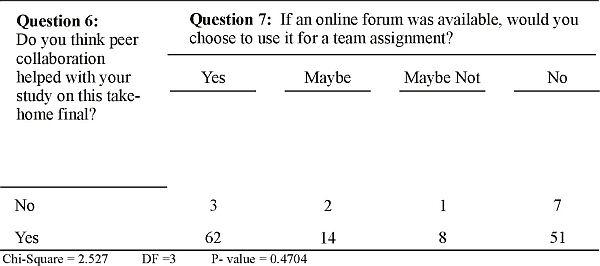
This study provides evidence that structured and moderated online peer collaboration during group problem solving may result in superior reasoning and better attitudes toward collaboration, without significantly increasing the time students must invest in the learning activity.
This finding may actually underestimate the importance of moderation, because the differences between the peer-controlled and moderated conditions also favored the structured and moderated condition and approached statistical significance for quality of solution (p = 0.096). The ceiling effects may also have limited the power of the treatment. Perhaps studies looking at different content, employing different problem types (ill-structured problems, for example), using subjects of different ages or academic abilities, or even using more than 18 groups per condition would identify differences in the quality of the solution that are statistically significant. Another area worthy of further investigation is the effect of peer online collaboration on individual achievement and the relationships between learner characteristics and the type of online collaboration on performance during problem solving.
These findings are consistent with socio-cultural learning theories and illustrate the critical importance of the instructor's changed role in online collaborative learning. Researchers and scholars believe that collaborative learning is a dynamic process, in which learners are more actively involved (Flannery, 1994; Hamm & Adams, 1992), and learners' active control over the learning activities is reported to enhance learning (Jensen, 1996). The moderator's role, as defined in this study, can enhance the value of the online collaborative learning experience.
Ahern, T. C., Peck, P. L., & Laycock, M. (1992). The effects of teacher discourse in computer-mediated discussion. Journal of Educational Computing Research, 8(3), 291-310.
Althauser, R. & Matuga, J. M. (1998). On the pedagogy of electronic instruction. In C. Bonk & K. King (Eds.), Electronic collaborators: Learner-centered technologies for literacy, apprenticeship, and discourse . Mahwah, NJ: Lawrence Erlbaum Associates.
Aviv, R. & Golan, G. (1998). Pedagogical communication patterns in collaborative telelearning. Journal of Educational Technology Systems, 26(3), 201-208.
Barrows, H. S. (1985). How to design a problem-based curriculum for pre-clinical years. NY: Springer Publishing Co.
Barrows, H. S. (1996). Problem-based learning in medicine and beyond: A brief overview. In L. Wilkerson, & W. H. Gijselaers (Eds.), Bringing problem-based higher education: Theory and practice: New directions for teaching and learning. San Francisco: Jossey-Bass.
Barrows, H.S., & Tamblyn, R.M. (1980). Problem-based learning: An approach to medical education. NY: Springer Publishing.
Blumenfeld, P.C., Marx, R. W., Soloway, E., & Krajcik, J.(1996). Learning with peers: from small group cooperation to collaborative communities. Educational Researcher, 25(8), 37-40.
Bonk, C., & Cunningham, D.J. (1998). Searching for learner-centered, constructivist, and sociocultural components of collaborative educational learning tools. In C. Bonk & K. King (Eds.), Electronic collaborators: Learner-centered technologies for literacy, apprenticeship, and discourse . Mahwah, NJ: Lawrence Erlbaum Associates.
Bosworth, K., & Hamilton, S. J. (eds.) (1994). Collaborative learning: Underlying processes and effective techniques. San Francisco: Jossey-Bass.
Boud, D. (1985). Problem-based learning in education for the professionals . Higher Education Research And Development Society of Australia, Kensington, NSW, Australia.
Boud, D., & Feletti, G. (1991). The challenges of problem-based learning. London: Kogan.
Bouhuijs, P. A. J., Schmidt, H. G., & Berkel, H. J. M. van (1993). Problem-based learning as an educational strategy . Maastricht, the Netherlands: Network Publications.
Bransford, J. D., Brown, A. L., & Cocking, R. R. (Eds.). (2000). How people learn: Brain, mind, experience, and school. Washington, DC: National Academy Press.
Bransford, J. D., Sherwood, R. D., & Sturdevant, T. (1987). Teaching thinking and problem solving. In J. B. Baron & R. J. Sternberg (Eds.), Teaching thinking skills: Theory and practice (pp. 162-181). New York: W. H. Freeman and Company.
Bransford, J. D., & Stein, B., S. (1993). The IDEAL problem solver: A guide for improving thinking, learning, and creativity (2nd ed.). New York: W. H. Freeman and Company.
Bruffee, K. (1999). Collaborative learning: Higher education, interdependence, and the authority of knowledge (2nd ed.). Baltimore and London: the Johns Hopkins University Press.
Coles, C. (1991). Beyond PBL. In D. Boud, & G. Feletti (Eds.), The challenge of problem-based learning. London: Kogan Page.
Driscoll, M. (1994). Psychology of learning for instruction . Boston, MA: Allyn and Bacon.
Flannery, J. L.(1994). Teachers as co-conspirator: knowledge and authority in collaborative learning. In K. Bosworth & S. J. Hamilton (Eds.), Collaborative learning: Underlying processes and effective techniques (pp. 15-23). San Francisco: Jossey-Bass Publishers.
Gredler, M.E. (1997). Learning and instruction: Theory into practice (3rd ed.). NJ: Prentice-Hall, Inc.
Hamm, M. & Adams, D. (1992). The collaborative dimensions of learning. Norwood, NJ: Ablex Publishing.
Hannafin, M., Land, S., & Oliver, K. (1999). Open learning environments: foundations, methods, and models. In C. Reigeluth (Ed.), Instructional-design theories and models: A new paradigm of instructional theory, Volume II, 115-140. Mahwah, NJ: Lawrence Erlbaum.
Harasim, L. M.(1990). Online education: An environment for collaboration and intellectual amplification. In L. M. Harasim (Ed.), Online education: Perspectives on a new environment. NY: Praeger.
Hooper, S. (1992a). The effects of peer interaction on learning during computer-based mathematics instruction. Journal of Educational Research, 85, 180-189.
Hooper, S. (1992b). Cooperative learning and computer-based instruction. Educational Technology Research and Development, 40(3), 21-38.
Jensen, E. (1996). Brain-based learning. Del Mar, CA.: Turning Point Publishing.
Johnson, D. & Johnson, R. (1975). Learning together and alone . Englewood Cliffs, NJ: Prentice-Hall.
Johnson, D.W. & Johnson, F. (1987). Joining together: Group theory and group skills. New Jersey: Prentice Hall.
Johnson, R.T., Johnson, D.W. & Stanne, M.B. (1986). Comparison of computer-assisted cooperative, competitive, and individualistic learning. American Educational Research Journal, 23, 382-392.
Jonassen, D. H. (1997). Instructional design models for well-structured and ill-structured problem-solving learning outcomes . Educational Technology, Research and Development, 45(1), 65-94.
Lin, X., Hmelo, C., Kinzer, C. & Secules, T. (1999). Designing technology to support reflection. Educational Technology, Research and Development, 47(3), 43-62.
Lohman, M. C. & Finkelstein, M. (2000). Designing groups in problem-based learning to promote problem-solving skills and self-directedness. Instructional Science, 28(4), 291-307. Netherlands: Kluwer Academic Publishers.
Nitko, A. J. (1996). Educational assessment of students (2nd Ed.). NJ/ Ohio: Merrill Prentice Hall.
Orrill, C. H. (2000, April). Designing a PBL experience for online delivery in a six-week course. Paper presented at the Annual Meeting of the American Educational Research Association, New Orleans, LA.
Ruberg, L.F., Moore, D. M., & Taylor, C.D. (1996). Student participation, interaction, and regulation in a computer-mediated communication environment: A qualitative research. Journal of Educational Computing Research , 14(3). 243-268.
Sage, S. M. (2000, April). The learning and teaching experience in an online problem-based learning course. Paper presented at the Annual Meeting of the American Educational Research Association, New Orleans, LA.
Scardamalia, M. & Bereiter, C. (1994). Computer support for knowledge-building communities. The Journal of the Learning Sciences , 3(3), 265-283.
Schmidt, H. G. (1989). The rationale behind problem-based learning. In H. G. Schmidt & M. W. de Vries & M. Lipkin, Jr. & J. M. Greep (Eds.), New directions for medical education: Problem-based learning and community-oriented medical education (pp. 105-111). New York: Springer-Verlag.
Schwartz, D., Lin, X., Brophy, S. & Bransford, J. (1999). Toward the development of flexibly adaptive instructional design. In C. M. Reigeluth (Ed.), Instructional-design theories and models: A new paradigm of instructional theory (Volume 2). Mahwah, NJ: Lawrence Erlbaum Associations, 183-213.
Vygotsky, L.S. (1978). Mind in society: The development of higher psychological process. Cambridge MA: Harvard University Press.
Wertsch, J.V. (1985). Vygotsky and the social formation of the mind. Cambridge, MA: Harvard University Press.
Zhang, K., & Harkness, W. L. (2002). Groups going online in a large class: Critical reflections. Journal of Interactive Instructional Development, 14(3), 14-18.
Group ID:________________________
Number of people in your group working on the take-home final: _______
For Items 1-3, please circle the letter before the choice of your response.
1. Which method were you assigned to use for peer collaboration on your take-home final?
Peer-controlled online forum
Structured online forum
2. As an individual, how much time did you spend on peer collaboration to complete the take-home final? Please include all the time you spent on discussion with your group member, such as online forum, during computer studio lab sessions, by the phone, out class meeting, via email, etc.
A. 60 minutes or less
B. 61 minutes to 120 minutes
C. 121 minutes to 180 minutes
D. 181 minutes or more
3. For your group, how much time did you spend on peer collaboration to complete the take-home final? Please include all the time you spent on collaboration with your group member, such as online forum, during computer studio lab sessions, by the phone, out class meeting, via email, etc.
A. 60 minutes or less
B. 61 minutes to 120 minutes
C. 121 minutes to 180 minutes
D. 181 minutes or more
Item 4 is composed of two parts, I and II. For Part I, in the left column, please circle the letter(s) before the choice(s) of your response; please choose all that apply; for Part II, in the right column, please write your response to the specific question(s) on the blank line.
4.

| For Items 5-7,
please write down your responses in the blank. Please feel free to use the back page, if needed. |
5. Did you feel it was difficult to collaborate with your group members and/or other classmates when completing the take-home final for Stat200? Why or why not?
6. Do you think peer collaboration helped you study for the take-home final? Why or why not?
7. If an online forum was available, would you choose to use it for a team assignment? Why or why not?
Thank you very much for your participation!
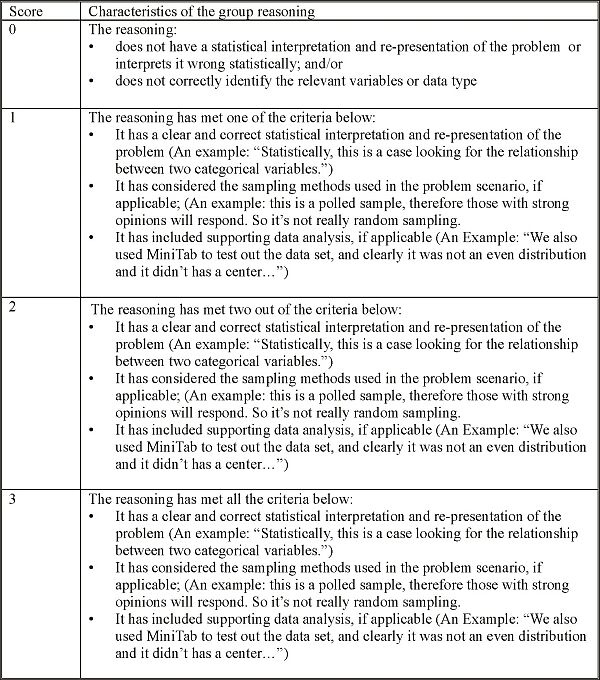
© Canadian Journal of Learning and Technology